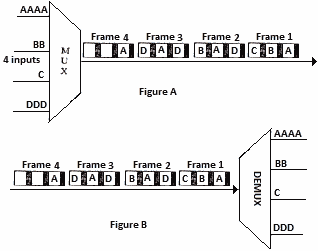Multiplexing
Multiplexing is the set of techniques that allows the simultaneous transmission of multiple signals across a single data link. Whenever the transmission capacity of a medium linking two devices is greater than the transmission needs of the devices, the link can be shared in order to maximize the utilization of the link, such as one cable can carry a hundred channels of TV.
Type of multiplexing
There are two basic techniques:
- Frequency-Division Multiplexing (FDM)
- Time-Division Multiplexing (TDM)
- Synchronous TDM
- A-Synchronous TDM
These types of multiplexing are shown in the figure.
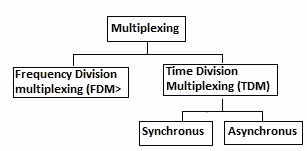
FREQUENCY-DIVISION MULTIPLEXING (FDM)
In FDM, signals generated by each sending device modulate different carrier frequencies. These modulated signals are then combined into a single composite signal that can be transported by the link. The carrier frequencies have to be different enough to accommodate the modulation and demodulation signals. The figure No.8.3 illustrates the FDM multiplexing process. The multiplexing process starts by applying amplitude modulation into each signal by using different carrier frequencies as/i and/j. Then both signals are combined
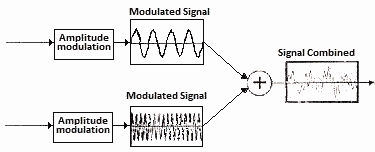
In demultiplexing process, we use filters to decompose the multiplexed signal into its constituent component signals. Then each signal is passed to an amplitude demodulation process to separate the carrier signal from the message signal. Then, the message signal is sent to the waiting receiver. The process of demultiplexing is shown in the figure.
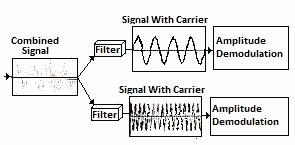
TIME-DIVISION MULTIPLEXING (TDM)
In the time-division multiplexing, multiple transmissions can occupy a single link by subdividing them and interleaving the portions. We say that TDM is a round robin use of a frequency. TDM can be implemented in two ways: synchronous TDM and asynchronous TDM.
1. Synchronous TDM
The multiplexer allocates exactly the same time slot to each device at all times, whether or not a device has anything to transmit. Time slot 1, for example, is assigned to device 1 alone and cannot be used by any other device as shown in the figure
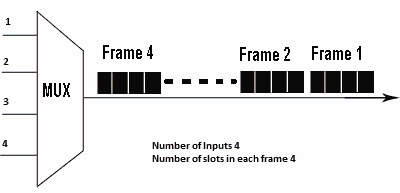
Frames:In synchronous TDM, a frame consists of one complete cycle of time slots. Thus the number of slots in frame is equal to the number of inputs.
Figures (A & B) below are an example of how/the synchronous TDM works.
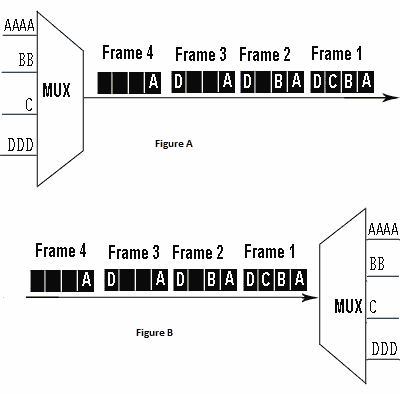
2. Asynchronous TDM
In asynchronous TDM, each slot in a frame is not dedicated to the fix device. Each slot contains an index of the device to be sent to and a message. Thus, the number of slots in a frame is not necessary to be equal to the number of input devices. More than one slot in a frame can be allocated for an input device Asynchronous TDM allows maximization the link. It allows a number of lower speed input lines to be multiplexed to a single higher speed line. As shown in the figure
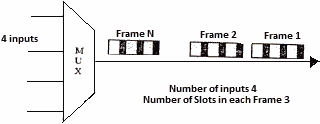
Frames: In asynchronous TDM, a frame contains a fix number of time slots. Each slot has an index of which device to receive.
Figures (A& B) are examples of how asynchronous TDM works.
